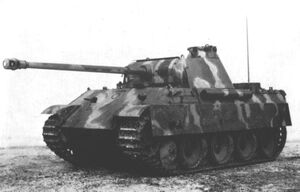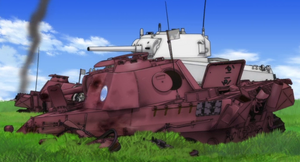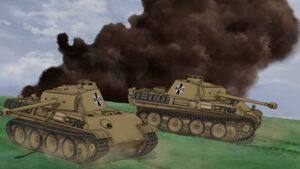- "Panther 1, Immobilized!"
- ―Koume Akaboshi
The Panther (its ordnance designation being Sd.Kfz. 171, and until 1944 being designated Panzerkampfwagen V Panther) was a German medium tank, recognized as one of the most successful and influencing tanks of World War II.
A bit of history
The Panther was conceived as a response to the Soviet T-34 and KV tanks, whose combat performance had surprised many of the Wehrmacht's top brass in the early stages of Operation Barbarossa; especially the T-34, with its combination of a long-caliber gun, sloped armor and wide tracks, was far more capable than the German Panzer III and Panzer IV medium tanks.
Both Daimler-Benz and MAN designers were asked to come up with a German equivalent to Soviet armor; although it was the DB's design to be approved at first, in the end it was the MAN project that went into production. The Daimler-Benz design was essentially a slightly modified T-34, and this was deemed unsuitable for purpose, given the inability of Germany to match Russian tank production, so the MAN design was instead approved. Initially designed to weigh around 35 tons, Adolf Hitler's insistence at increasing its armor protection pushed up the weight at 45 tons; despite this, with the same Maybach HL230 of the Tiger heavy tank, the Panther would prove to have better maneuverability, while the superlative KwK 42 L/70 75 mm gun gifted it with excellent firepower.

Panzer V "Panther" Ausf. G
When it first saw combat, around Kursk during Operation Zitadelle in July 1943, the Panther had been rushed to the frontline (in fact, the same date for the offensive had been moved to allow for the Panther to get to the frontline), so its initial performances were disappointing, with many Panthers being lost to technical trouble (the engine was poorly ventilated and therefore tended to overheat, and it proved prone to catching fire). Other problems, like the weak and unreliable final drive units, and the advanced but complicated suspension, were never fixed, and followed the tank throughout its career.
Despite this rocky start, once the bugs had been worked out, the Panther truly began to shine; its good frontal armor (the only weak point being a shot trap in the lower turret section, later fixed) and its powerful gun made it ideal as a sniper in open-country, where its excellent optics and its gun's penetration could be a lethal combination. Its large and tall silhouette, together with its weak side and rear armor, made it wholly unsuitable for close-combat warfare. At combat ranges it routinely outperformed the Allied and Soviet tanks it faced initially (like the M4 Sherman or the T-34).
The Soviet designers answered to this by turning to their improved T-34/85 and then to the IS heavy tanks, which could engage Panther and Tigers on more equal terms. Allied response was much slower, thanks to a sense of complacency compounded by the false belief that the Panther wouldn't be produced en masse. On the Western Front most of the Allied tanks were challenged by the German tank, with only the British Sherman Firefly and the American M36 Jackson tank destroyer being capable of penetrating the Panther's frontal armour at range; its side and rear armour was comparatively thin, however, and presented an easier target for Allied tanks.
However, the real problem of the Panther was one of numbers; despite being the third most produced German tank design during the war (with some 6'000 units of all kinds), and sprouting derivatives like the fearsome Jagdpanther tank destroyer, it was never produced in numbers high enough, and it never replaced the less advanced but cheaper Panzer IV. Its inferior opponents, therefore, could bring their numbers to bear, with any Allied or Soviet tank having plenty of replacements available, while any Panther lost was irreplaceable.
Nonetheless, the Panther has been positively evaluated by most military and tank historians; its influence is clearly visible on most post-war tank designs (like the Soviet IS tank lineage or the American M26 Pershing heavy tank).
In Girls und Panzer
Kuromorimine Girls High School has several Panthers in its arsenal.
During the Tournament's Finals, Kuromorimine employed several Panthers as the backbone of its force, with the heavier vehicles being the ones supposed to bring the opponents down; however, thanks to Ooarai Girls High School's unorthodox tactics, this often forced them to engage in unfavourable tactical conditions. Unsurprisingly, this caused the Panthers to take a good share of the losses at the hand of Ooarai's tanks, with some being taken out by skilled marksmanship (in the case of Miho Nishizumi's Panzer IV) or by superior firepower (as proved by Ooarai's Tiger (P)).
A Panther commanded by the Panther Commander was one of the tanks that was tricked by Turtle Team's Hetzer pulling up to their encirclement line, with the Panther Commander not noticing it until it pulled up between two of her fellow tanks. When she tried to direct tanks to engage the small tank destroyer, they came under heavy fire from Ooarai on the high ground. The subsequent chaos caused her to pull the entire left flank back to reform another defensive line, but this proved to be in vain as they were unable to prevent Ooarai's team from breaking out of the encirclement.
Koume Akaboshi and Jagdpanther Commander were the commanders of the two Panthers sent to reinforce Ooarai during the battle against Selection University. They were taken out fairly early in the game by artillery.
Der Film
Two Panthers were part of the Kuromorimine detachment sent to reinforce the Ooarai Compound Team. One was commanded by the Jagdpanther Commander, while the other was commanded by Koume Akaboshi. Both were taken out relatively early in the game by the Karl-Gerat.
Tank basic characteristics
Kuromorimine employs several Panther tanks.
- Armament
- Main Gun : 7.5 cm KwK 42 L/70 gun
- Other : 2x 7.92 mm MG 34 machine-guns
- Hull armor/Turret armor
- Front : 85 mm / 100 mm
- Sides : 50 mm / 45 mm
- Rear : 40 mm / 45 mm
- Speed : 45 km/h (29 mp/h) on road




